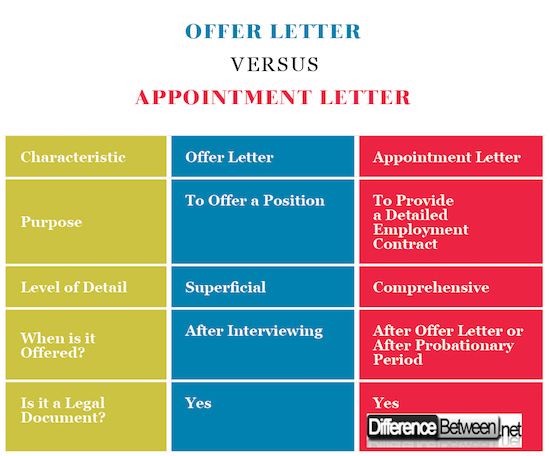Differences Between Appointment Letters and Offer Letters
What is a Offer Letter?
An offer letter is a document that employers send to announce a job offer to a candidate. Offer letters are usually the next step after the interview process and contain superficial information about the potential position, such as the company’s location and the proposed salary.
What is a Appointment Letter?
Appointment letters follow offer letters once a candidate has confirmed that they would like to accept the job in question. These letters provide more detail about the position in order to help the new employee prepare for work, and also serve as proof of the employment contract between the company and the new hire.
Differences between Appointment and Offer Letters
Purpose
Offer letters are designed to inform a candidate that they have been selected for a position. The letter typically includes basic information so that the candidate can decide whether the job is truly right for them. A candidate who accepts a job offer can use their offer letter to resign from their current work with relative impunity – an offer letter is an appropriate method for breaking a current employment contract.
Appointment letters provide more information than offer letters because they are sent after a candidate has accepted the position in the offer letter. An appointment letter can be used as proof of upcoming employment and is considered a formal copy of the contract the candidate agreed to by accepting the job offer.
Timeline
Offer letters are given after a candidate has interviewed and completed any preliminary processes like providing references or undergoing a background check. If the hiring process is more informal, it’s possible that an employer could send an offer letter without conducting an interview, but this is uncommon unless the employer and candidate already know each other. At this point in the hiring process, an employee can still decline the offer without being disrespectful, as a company usually won’t send out rejection letters until the desired candidate has formally accepted the position.
By definition, an appointment letter always comes after an offer letter. In the private sector the appointment letter usually comes before the employee starts working. For government jobs, however, an appointment letter is often not given until the new hire has finished a probationary period with an agency. If this is the case, then the new hire is not considered a full employee until receiving an official contract in the form of an appointment letter, and can easily be fired before that. Although an appointment letter is not inherently binding like a contract, it is considered rude to reject the job at this point (barring a serious life crisis interfering) because the candidate has already accepted the position and the company has likely rejected all other candidates.
Provided Information
An offer letter should contain enough detail that the candidate can comfortably accept or reject the position, but this letter does not need to provide a lot of information. While employers shouldn’t hide any pertinent details by omitting them from the offer letter, at this stage the candidate does not need to know the minutiae of the job. A typical offer letter includes at least the position title and any ranking (like a GS worker level), salary, location, and start date. If the candidate needs to complete more paperwork before they can start working – finalizing a background check or security clearance, for instance – the employer should mention this within the offer letter.
An appointment letter should be much more detailed than the preceding offer letter. This letter delineates specific tasks and duties that the candidate is expected to perform, total hours of work per week, and any benefits like vacation time and health insurance. Because an appointment letter is essentially a contract, it can also include terms of employment, methods of termination, and any additional details that are particular to the company.
Comparison Table to show the differences between Appointment and Offer Letters
Summary of Appointment letters Verses Offer Letters
Offer letters and appointment letters are both formal versions of an employment contract that are provided during the hiring process. However, their purposes are unique.
- Offer letters are usually the first version of the employment contract and are used to inform a candidate that they have been found suitable for the position in question.
- If the candidate affirms that they want to accept the position, then the company can provide an appointment letter with more details regarding the job.
- Offer letters typically repeat information from the interview as well as anything else considered critical, like the projected start date. In contrast, appointment letters are very detailed, like a contract.
- Both offer letters and appointment letters are legal documents and can be used in any capacity in which the candidate needs to prove their employment status. The candidate may need an offer letter to resign from their current job, or they may need an appointment letter to help obtain a lease if they are moving for work.
- Differences Between Google Fi and T-Mobile - August 18, 2019
- Differences Between LED Bulbs and LED Fixtures - June 1, 2019
- Differences Between McAfee and Kaspersky - April 22, 2019
Search DifferenceBetween.net :
Leave a Response
References :
[0]Susan S. Davis. “The Difference Between an Appointment Letter & Offer Letter.” Bizfluent. September 26, 2017. https://bizfluent.com/info-12154961-difference-between-appointment-letter-offer-letter.html
[1]“Offer Letter Vs Appointment Letter.” CiteHR. May 14, 2010. https://www.citehr.com/253741-offer-letter-vs-appointment-letter.html
[2]Image credit: http://www.thebluediamondgallery.com/highlighted/images/employment-contract.jpg
[3]Image credit: https://pxhere.com/en/photo/916968



